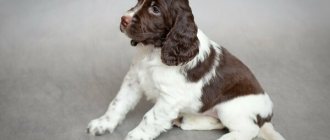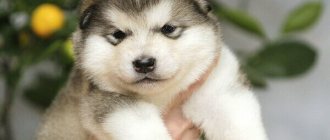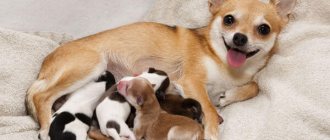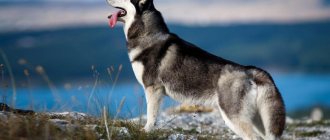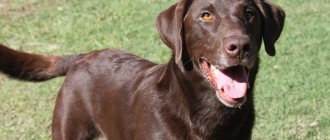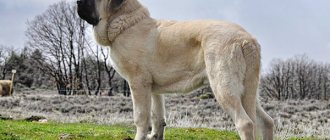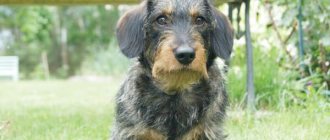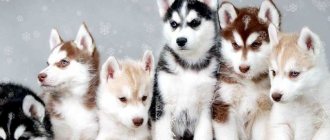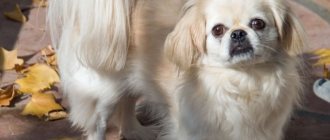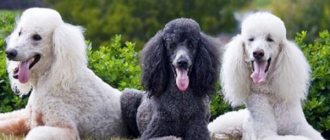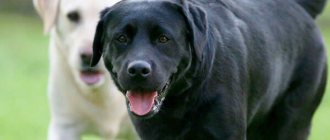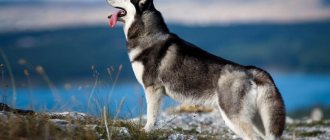The history of spaniels begins in the 14th century. In 1801, the breed was divided into two varieties: springers (hounds) and cockers, used for hunting woodcocks (birds leading a crepuscular lifestyle). As a result, in the 19th century, cocker spaniels were considered a whole dozen similar breeds, called field hunting dogs. The confusion ended in the early 20th century when the Kennel Club of Great Britain identified the English Cocker Spaniel as a separate breed. Today it is considered more decorative than hunting.
American and English Cocker Spaniels are small dogs that grow at the same rate. Owners should monitor their puppies' weight gain to monitor their development.
Types of puppies and their descriptions with photos
Spaniels are smart, quick-witted, loyal, sociable and friendly dogs that are quite easy to train..
There are many varieties of this breed, but the most common are English, American and Russian spaniels.
English
The first representatives of this breed were much larger than modern ones . To reduce their size, these dogs were mated with Japanese spaniels presented to the Queen of England.
This is how English spaniels were bred, distinguished by their more compact size, mobility, endurance and developed sense of smell.
These dogs are distinguished from American and Russian spaniels by their body proportions, as well as the size and shape of their heads.
“English” - owners of a dense physique with well-developed muscles, a short body, strong strong limbs and a slightly convex and flattened head in front.
Representatives of this breed grow to 34-41 cm at the withers and weigh 12-16 kg. Puppies of this breed reach their maximum height at about one year of age.
These dogs have a long, silky and thick coat, without curls, waves or curls. From time to time, these dogs need a haircut.
American
This variety is the descendant of the English spaniel, so their appearance is quite similar. “Americans” are slightly smaller in size, growing at the withers to 35-39 cm with a body weight of 12-14 kg.
These dogs have large expressive eyes, a shorter muzzle and a clearly defined transition from the forehead to the muzzle..
The coat of American Spaniels is longer, thicker and more luxuriant, with curls of hair on the ears, belly and chest.
These dogs have a developed hunting instinct, but are now more often used as a decorative breed.
Russian
Russian spaniels have collected the blood of different types of spaniels..
The goal of Soviet breeders was to develop a breed that would be most suitable for hunting in Russian conditions, therefore representatives of this breed have a slightly longer body and limbs - this makes galloping easier in difficult places.
The height of Russian spaniels at the withers is 36-44 cm, weight - 13-18 kg . They have a light, slightly convex head at the sides and an almost rectangular profile. The coat is of medium length and density. The color can be varied - black, red, brown and others.
Collar sizes for Cocker Spaniel
Collar sizes you need to consider before purchasing:
- Full length.
- Length to clasp.
- Width.
When choosing a collar, it is extremely important to pay attention to the types of fasteners and materials from which the accessories are made. For American and English Cocker Spaniels, the following collar sizes are suitable:
- SM: 35–41cm.
- M: 39–45cm.
A fastened collar should not put pressure on your pet's neck or interfere with it in any other way. Two fingers should fit and rotate freely between the neck and the collar.
Advice: for the convenience of the ward, it is better to opt for a collar that is properly fastened to 1-2 holes or purchase a nylon collar that is adjustable in length.
Basic rules of care
Despite the fact that newborn puppies are completely helpless, their eyes and ear canals are closed and they lack their own thermoregulation, caring for them requires minimal effort on the part of the breeder, since the main concerns fall on the bitch.
IMPORTANT!
All that is required from the owner is to ensure that they are well-fed, supplementing them with a bitch milk substitute if necessary, and also control their temperature, which normally should be 34.5-36 °C.
If the litter is separated from the bitch, the temperature in their bed must be maintained at least +30 °C, otherwise the puppies may freeze and die.
How to bathe properly
Spaniels cannot be bathed until the quarantine period ends after the last vaccination. The exception is cases when the puppy is very dirty, but it is better to try to minimize the likelihood of this.
During the first bath, you should lay a rubber mat on the bottom of the bath so that your pet’s paws do not slip, and cover your ears with cotton swabs, eliminating the possibility of water getting into them..
The coat of representatives of this breed should be brushed 3-4 times a week, or better yet, daily. This will help get rid of dead hair and avoid the formation of tangles.
Claws
For the first time, puppies' nails need to be trimmed around the 8th day after birth to prevent them from scratching their mother's nipples, then repeat the procedure weekly, cutting off sharp edges.
Adult dogs' nails should be trimmed once every 3-4 weeks..
Eyes
These dogs are prone to eye inflammation. To avoid this, you need to wipe the puppies’ eyes daily with a cotton pad soaked in chamomile infusion or boiled water.
If there is increased lacrimation, purulent discharge or photophobia, you should contact your veterinarian.
Ears
Spaniels have long, drooping ears, which helps protect the ear canals from foreign objects entering them, but at the same time causes poor ventilation and, as a result, increases the risk of developing inflammatory diseases.
Ears should be cleaned once a week using cotton swabs and a special product that helps soften and remove wax, and ventilate daily, minimizing the risk of pathologies..
What is forbidden to give
Adults and puppies are strictly prohibited from feeding the following categories of foods:
- tubular bones (chicken and rabbit)
- pasta and baked goods
- pork
- smoked meats
- fried, spicy, pickled food
- River fish
- onions, garlic (large quantities)
- millet cereal
- mushrooms
- unheated white cabbage.
In this article we looked at feeding options for a spaniel. When choosing a feeding diet, you need to take into account many factors that influence the daily energy expenditure of a puppy and an adult dog. Proper and balanced nutrition is the key to a healthy, active and cheerful pet.
How to toilet train
The puppy cannot be taken outside during quarantine after vaccinations, so it is important to accustom him to the toilet in the house so that he does not shit in inappropriate places.
The most effective way is to limit the pet’s space by allocating it a separate room or part of the room, where the floor will be completely covered with sanitary diapers or newspapers..
This will not allow the puppy to relieve itself by. Gradually you need to reduce the number of diapers, leaving only 1 at the end, which over time can be moved to the place reserved for the toilet.
If it is impossible to limit the dog's space, it is necessary to spread diapers throughout the apartment or house, especially near doors and windows.
It often happens that a puppy, despite all the diapers, goes to the toilet in a certain place that, for some reason, he chose on his own; in such a situation, it is important to lay the diaper there, even if it is not entirely convenient for the owner.
When the pet gets used to relieving itself on the diaper, it can be moved to another place.
CAREFULLY!
The puppy should be taken to the diaper after sleeping, eating and active games and should not be allowed to leave until he relieves himself.
You can use special sprays, the effect of which is aimed at toilet training your pet - they need to be sprayed on a cloth or piece of paper and placed on a diaper.
The spray emits a specific aroma that is captured by dogs' sensitive sense of smell, indicating the correct place for the toilet..
After the end of quarantine, your pet can be trained to use the toilet outside. To do this, the dog needs to be taken for a walk in the morning and every 40-60 minutes. after feeding and wait until he goes to the toilet.
Brief history of the breed
The history of the breed dates back several thousand years before the present day. The ancestors of cocker spaniels are considered to be ash dogs, which are so called because of the remains found in the ash. The assumption is that these animals were previously burned at the stake in honor of the worship of the gods. However, most dogs were kept to help in hunting.
The next stage is the meeting of similar animals in Greece. Characteristic features included short stature, drooping ears, and long hair. Then the animals began to spread throughout the world and reached England.
They didn’t know about genetics at that time, so selections were made based on obvious working qualities. Dogs were bred only with hunting skills suitable for their owners. The animals spread across different territories with a variety of game, which affected the breeding qualities.
This led to the emergence of two types of breed:
- water spaniels - helped in hunting game birds in water bodies;
- Land Spaniels - used by hunters on land.
Closer to the 19th century, breeding work began to develop. During this period, most of the basic lines of spaniels were formed, which became the basis for modern pets. In 1893, the Cocker Spaniel standard was adopted, but the breed was recognized as an independent unit only at the end of the 20th century.
The importance of the information presented is to determine the height and weight categories of the animal. A brief history of the breed largely explains the appearance, physique, character, and health characteristics of the dog
What to feed for the first 3 months?
For at least 2-3 weeks, and preferably 30-40 days, the main food for puppies should be mother's milk.
The exception is when this is impossible for some reason, then the breeder needs to feed the entire litter himself, using unsweetened and lactose-free infant formula or, better yet, special bitch milk substitutes, for example, Royal Canin Babydog Milk.
After the main lactation period, i.e. about a month after the puppies are born, they need to start giving complementary foods in the form of ground vegetables, fermented milk products or soaked dry food.
NOTE!
The amount of complementary feeding should be gradually increased by adding new products, including boiled ground beef, low-fat broth, some offal (heart, lung, liver) and porridge cooked in broth.
At 2 months, the puppy should be familiar with most of the foods allowed for spaniels in order to be as prepared as possible for moving to a new home.
New products must be introduced into the menu gradually, observing how the puppies’ bodies react to them and whether there are any negative reactions.
What to look for when choosing a diet
In order for feeding to give positive results, the pet does not starve, but also does not overeat, several important factors must be taken into account:
- Pet size. This parameter varies quite a lot among cockers; for example, a Russian spaniel is significantly larger in size than a Japanese or toy spaniel. Therefore, the volume of food must correspond.
- Age of the dog. Puppies, especially during the period of active growth, require a lot of nutritious food, and in this case, abundant feeding will only be beneficial (provided that all the foods are “correct”). In older dogs, physical activity decreases, and therefore calorie consumption also decreases.
- Physical activity. A lot also depends on the load the pet receives. If a spaniel performs hunting duties or participates in sports competitions, then its activity requires a more high-calorie and nutritious diet than for its less active counterparts.
- Character traits. Although the majority of cockers are tireless runners and gamers who can independently entertain themselves, and even set up a playground in a small apartment, it is rare, but there are still lazy individuals for whom dozing all day is the best way to spend leisure time. For this category, the portion of food can be safely reduced by a quarter; this will not harm energy-saving dogs.
- Physical state. Enriching the diet with protein products, as well as food containing large amounts of microelements and vitamins, is necessary in the postoperative period, as well as during recovery from illness, bearing and feeding offspring.
- Tendency to allergies. Cockers, especially the decorative types, are prone to this condition. Therefore, all new products must be tested with very small amounts and then observed for the reaction. If the body reacts negatively - skin irritation, itching appears, the dog tears profusely, or has trouble breathing - the irritating product should be strictly prohibited.
How to feed correctly and how often
The main thing to remember when choosing food for a puppy is that the diet should be balanced and contain all the vitamins and minerals necessary for healthy growth and development.
As the puppy grows up, not only its diet changes, but also its diet and the number of feedings per day, replenished with new products.:
- up to 2 months of puppy – 6 times;
- 2-4 months – 5 times;
- 4-6 months – 4 times;
- 6-10 months – 3 times;
- after 10 months – 2-3 times.
Improper feeding, deprived of essential macro- and microelements, often causes the development of dangerous pathologies.
Weekly menu for a 4 month old puppy
| Day of the week | Menu |
| Monday | Oatmeal and buckwheat porridge with vegetable oil, stewed vegetables, boiled veal, natural yogurt |
| Tuesday | Rice porridge with stewed vegetables, boiled beef, sour cottage cheese, boiled egg, buckwheat porridge in broth |
| Wednesday | Oatmeal, calcined cottage cheese, boiled sea fish, low-fat kefir, finely chopped zucchini, bell pepper and carrots |
| Thursday | Rice porridge with vegetable oil and stewed pumpkin, natural yogurt, calcined cottage cheese, beef offal |
| Friday | Buckwheat porridge with stewed vegetables, kefir, boiled turkey, calcined cottage cheese |
| Saturday | Oatmeal, boiled beef and turkey, boiled beets, natural yogurt |
| Sunday | Rice porridge with boiled beets and fresh bell pepper, boiled beef, calcined cottage cheese, boiled egg, buckwheat porridge in broth |
What to look for when choosing a diet
The choice of diet and type of food must be taken responsibly. There are currently two options for feeding dogs:
- natural food;
- prepared dry and canned food.
There are two advantages to feeding your pet with ready-made dry and canned food:
- high-quality industrial feed is fully balanced in terms of nutrients, vital micro- and macroelements, as well as vitamins;
- Significant time savings on preparing food for your pet.
Vaccination schedule
| Age | Nobivak vaccine | Eurikan vaccine |
| 7 weeks | Deworming | |
| 8-9 weeks (vaccination against plague, viral hepatitis, adenoviral infections, parvovirus enteritis, parainfluenza, leptospirosis) | DHPPiL | DHPPI2+L |
| 11 weeks | Deworming according to indications | |
| 12 weeks (vaccination against plague, viral hepatitis, adenoviral infections, parvovirus enteritis, parainfluenza, leptospirosis + rabies vaccination) | DHPPiL+R | DHPPI2+RL |
| 1 year | DHPPiL+RL | DHPPI2+RL |
| Vaccinations are then repeated annually at the same time. |
Measuring the height of a dog
Any control of the development of puppies, as well as determining the standard of a particular breed, requires certain measurements. First of all, it is a measurement of growth. We will talk further about how to correctly take this measurement.
From the video “Medical procedures and the withers of an animal” you will learn how to properly give injections in this area of the back.
Instructions
Below is a complete list of points, following which, you can correctly determine your height. Height is determined by measuring the distance from the highest point of the animal's body (withers) to the floor. In order for the measurements to be accurate, the pet must be placed on a flat horizontal surface. Most likely, you will need an assistant who will hold the animal in an even position, but without much strain on the muscles and paws.
Small breeds are best measured on a flat table surface, while large animals will be more comfortable on the floor. You can correctly determine the starting point by applying a ruler or book to the withers. A special stadiometer is usually used for measurement. However, if you don’t have it on hand, you can use the following methods.
- Two rulers. One of them should be placed on the pet’s back, the other should measure the distance from the floor to the second ruler. The best way to do this is shown in our photo.
- Children's method. If you are the owner of a large dog, you can measure your pet the same way you measure children. Place the animal against the wall and make a mark where the shoulder blades are located. This method is unlikely to be suitable for small breeds.
Height directly depends on the size of the breed to which the pet belongs
It is important to understand that this parameter may differ from breed standards if your puppy’s parents were representatives of different breed groups. In addition, in mongrels and pedigree crosses, it is generally impossible to predict it, since a large amount of blood is mixed there
Therefore, the size of a mature puppy can significantly exceed the size of its parents.
How to train correctly and what commands to teach?
Spaniels are intelligent dogs that are easy to train . Puppies quickly adapt to new conditions, adjusting to the rules established in the house and the owner’s lifestyle.
However, they need proper upbringing; you should not expect that the pet will learn everything on its own.
There are several basic recommendations that need to be taken into account when raising a spaniel.:
- It is best to start training when the puppy is 5-6 months old, this is the optimal time until the dog’s character is fully formed;
- It is necessary to work with your pet regularly - this is the only way to achieve positive results in the shortest possible time;
- The spaniel should be provided with sufficient physical activity and training should begin when the pet is reasonably tired, so as not to be distracted from activities;
- It is better to conduct training in a playful way;
- you cannot shout at the puppy or hit him;
- For correct execution of a command, the pet must be rewarded with praise and treats.
Representatives of this breed are friendly towards everyone, so it is necessary to show the puppy that he needs to behave with restraint with strangers, do not allow him to jump on passers-by or sniff them.
It is also important to teach your dog at least basic commands . First of all, you need to accustom your pet to its nickname, saying it out loud as often as possible when addressing it.
After the puppy begins to associate himself with the chosen name, you need to teach him the “Come to me” command, calling the spaniel by name and treating him with a treat when he comes.
You should also call him by name before feeding - this will help reinforce the dog’s positive associations with this command.
Place training is another important command . You should arrange a personal place for the dog where it will sleep and take the puppy there, saying the command “Place”.
When the baby remembers this and clearly understands where exactly his personal place is, this command can be a little more complicated: you need to leave the pet in any other place, say the command and leave, making sure that the puppy does not follow.
It is also important to master the commands “Fu” and “No”, pronouncing them loudly and clearly when the pet does something forbidden; at the same time as the command, you can take it by the withers and shake it slightly.
For the “Sit” command, you need to show the puppy a treat so that he raises his head and sits down; you can easily press on his croup and clearly pronounce the command.
Using the same principle, the “Lie down” command is mastered, only the puppy’s position changes..
In addition, it will not be superfluous to master the commands “Give me your paw”, “Nearby”, “Show your teeth”, and hunting dogs also need to be trained in fetching.
Key facts
The Russian Spaniel is an energetic, lively, inquisitive, optimistic and friendly pet. Nature has endowed the dog with excellent sense of smell and amazing endurance, which allows it to quickly and easily find birds in marshy or dry areas.
The spaniel is an incredibly smart, loyal and obedient dog that is strongly attached to its owner. He gets along well with small children, cats, dogs, and other pets. Such a pet will be an ideal companion for an active family and is definitely not suitable for elderly and constantly busy people.
Description of the Russian Hunting Spaniel breed includes:
- high level of intelligence;
- friendliness, sociability;
- well developed hunting qualities;
- easy training and education;
- rapid adaptation to a new environment;
- unpretentiousness in everyday maintenance, nutrition, care.
If the spaniel is considered in the role of a hunter, it is worth noting such qualities as: perseverance, activity, endurance and complete obedience. The pet swims well in water, dives, and follows all the owner’s commands if it is raised correctly.
The characteristics of the Russian hunting spaniel breed emphasize that this hunting dog is hardy, energetic, patient, persistent and at the same time attached to the owner and his family.
With proper maintenance and proper nutrition, the life expectancy of the Russian Hunting Spaniel is 9-11 years. For a hunting dog this is a normal period. Long-livers occur, but not so often.
The spaniel tolerates cold well, which makes it possible to keep it in the enclosure of a private house. In the winter season, the owner needs to take care of insulating the booth, since without the proper conditions the dog can get sick.
Popular nicknames for boys and girls
| Gender of the dog | Names |
| Male | Lorrie, Maurice, Tom, Neil, Archie, Luke, Mars, Oscar, Casper, Colin, Dani, Patrick, Barney, Dani, Bruno, Leo, Kevin, Monty, Simon, Derek, Watson, Bruce, Lucky, Tiktak, Chaplin, Elwood, Latte, Mickey, Twister, Elvis, Hustler, Rocky, Wally, Pancho, Ripley, Ozzy, Hiro (generous), Ren (lotus), Akira (bright), Arata (new), Yuki (snow), Haruki (shining ), Hayato (falcon), Hikari (light), Hinata (sunflower), Akito (autumn) |
| Bitch | Dolly, Sarah, Doni, Chloe, Trixie, Floris, Laura, Mimi, Irma, Christy, Dekla, Dori, Pixie, Eileen, Jena, May, Ruby, Cheri, Nancy, Lily, Betsy, Isa, Grace, Kira, Belle, Wendy, Linda, Sabina, Alice, Penelope, Sophie, Puma, Bridget, Snowball, Margo, Bagheera, Cleo, Sima, Lipa, Lada, Toffee, Fifa, Sabrina, Shinju (pearl), Kiku (chrysanthemum), Aimi (beautiful love ), Haru (spring), Natsumi (beautiful summer), Yuri (lily), Sakura (cherry blossom), Hoshi (star), Nami (wave) |
Learning ability
In terms of learning ability, the “star” character can again play a cruel joke. The Cocker must be constantly praised, but scolding is prohibited. The dog will understand the reproachful tone, but will simply demonstratively not react to the scream.
On the scale of intelligence and intelligence, a cocker deserves five points, but with reservations. We need to find an approach to this proud handsome man. He must be the best and the first in everything - the owner’s praise is the best incentive for training.
When is a puppy separated from its mother?
Newborn puppies depend on their mother to not only feed them, but also to keep them warm and lick them, stimulating defecation and urination..
Over time, the connection between the puppies and the bitch weakens - already about 14 days after birth, the babies’ eyes and auditory canals open and they begin to explore the world more independently.
Until about 30-40 days, the only food for puppies is bitch's milk, but already at the age of one month it is necessary to begin gradually introducing complementary foods gradually.
This means that small spaniels finally cease to depend on their mother and become completely independent.
Once the puppies reach 8 weeks of age, they are ready to go.
At 8-12 weeks they are independent, do not depend on their mother, but they have not yet developed behavioral habits, and their psyche, character and behavior are quite flexible, so babies adapt as easily as possible to a new home, easily remember the rules of behavior and are amenable to training.
Dimensions of a bed and a booth, a house or an aviary for a cocker spaniel
The Cocker Spaniel is an apartment dog, but for the purposes of education, safety, or temporary foster care, a cage or enclosure may be required. In addition, to organize a place for the dog to rest, you will need a lounger or a house.
Minimum sizes of a bed and a booth, a house or an aviary/cage for an American and English Cocker Spaniel:
- Rugs, beds - sizes L and M - minimum 50x50 cm excluding sides.
- Cage or enclosure - minimum 116x75x70 (width, depth, height).
The dog's enclosure should have a free space for a bed, bowls, and, if necessary, a tray.
Shchelkovo ROS
PUPPY
A guide for the owner of a Russian hunting spaniel puppy from the litter of my beloved dog Becky
“The first year of a working dog’s life is the foundation for the next 10 years of successful hunting.” Martynova Larisa Zakharovna, expert of the All-Russian category for spaniels
INTRODUCTION
I wrote this guide for those who have had a dog for a long time, in childhood, as well as for those who are entering this wonderful world of meeting a four-legged friend for the first time. I wanted to save you from minor mistakes and initial mistakes, to suggest the basic principles in raising and handling an animal so that you can devote more time to the final stage of learning - exercises, training and hunting.
The Russian Hunting Spaniel breed is distinguished by a balanced psyche, friendly character, good trainability and an innate passion for searching and pursuing game. These qualities put it on the same pedestal with other dog breeds known in the world.
We inherited a wonderful breed, appreciate this priceless gift and try to pass it on to our descendants!
Part 1 HOUSE
A spaniel puppy can live in an apartment, in a country house, in a private house, as well as in a well-maintained outdoor enclosure.
Floors The flooring in the room should, if possible, not be slippery; if this is the case, place rugs on the floor in the area of the house or apartment where the puppy spends the most time.
Steps A puppy under 4 months of age should not go down steps until the joints and bones of the forelimbs are stronger, otherwise this can lead to “sweeping” and curvature of the forearms. If you do not have the opportunity to protect the puppy from going up the stairs, when going down, hold the baby by the leash, reducing the load. You should also protect him from jumping off high objects (benches, sofas, porch).
Limit your young dog's climbing of stairs whenever possible. High steps force the short Spaniel to turn his knee outward, which brings the hocks closer together.
Wires in the house Move all wires in the house to a large height or to places inaccessible to the puppy. Try to immediately wean the puppy from showing interest in the wire - to do this, take a wire 2.5-3 m long and hold the end in your hand. As soon as the puppy begins to chew on it, then make a wave and imitate the movements of a boa constrictor, causing big trouble for the baby. It's better if it hurts a little at some point. In this case, the owner must pretend that he is not participating in this and not utter any words. The baby begins to fear wires and avoid them. The lesson should be repeated from time to time, throwing a wire into the room when the puppy is not in it.
Also, if your puppy doesn’t like anti-rodent, you can spray the end of this wire with it.
Place The best place for a puppy will be a corner in the entrance area of the home, but not on the passage, not near the radiator and without drafts. The litter should be thick enough, warm and soft, its approximate size is 60 by 90 cm. It is advisable that the litter have a removable cover that can be washed. For a bedding of this size, a disposable diaper from a pharmacy is suitable; it can be laid between the main bedding and the cover.
Bowl The bowl should be in a place accessible to the puppy at a low height, the surface of the water in the bowl should be at the level of the middle of the puppy's chest. A bowl placed too high will cause more harm than one placed on the floor. It is advisable to feed your spaniel from a stand, raising the bowl to chest level as the puppy grows. This will allow you to form the correct posture and increase your chances of raising a highly forward dog, which is stipulated by the breed standard.
There should be water in the bowl at all times. Choose a bowl size that can accommodate a whole portion of food. When eating, it is better to grab the puppy's ears from behind with a hair elastic.
Collar and leash A leather collar is preferable; its tightening should be such that two fingers can hardly fit under it. Immediately try to attach a tag with your phone number to the collar in case you lose your puppy. Choose a hard leash, up to 1.5 meters long. A roulette leash is convenient only in the first months, when the baby is still content with short walks and does not feel completely confident on the street.
Toys A variety of toys and games with the owner develop the puppy well and subsequently serve as one of the main tools for training. Play with your puppy as much as possible. Never use a sling while playing; it should only be used for exercise. Also beware of squeaky toys - they teach your puppy to chew, which can teach him to chew, crush and maul game. Toys that the puppy happily pulls on ropes are also not desirable.
Diarrhea First, a dry wing can serve as a diarrhea, then a small stick, 3–4 cm thick, wrapped in cloth with feathers tied on the outside. Also a piece of fire hose filled with sand, or best of all, a professional, non-sinking hose from a pet store.
Muzzle Accustom your puppy to a muzzle from an early age. A muzzle will help you in critical and unusual situations (in a hospital, in transport). A fabric muzzle is suitable for a spaniel.
Sometimes you have to use a muzzle outdoors as protection from picking up scattered food from the ground. For such purposes, a light, bulky plastic muzzle is suitable, which does not allow you to reach the food.
Carrying cage For a hunting dog that often goes hunting and walking with its owner, a carrying cage is very useful. When the dog gets used to it, he feels very comfortable, considering it his fortress. This device is especially convenient in the off-season, when a dog can dirty the inside of a car in a matter of seconds. Also, during hunting or competitions, the dog can be left in a carrier in the shade for quite a long time, which is very convenient.
You need to gradually accustom your puppy to a crate from a very early age. When the dog understands that only in a cage will it go on its favorite hunt or in the field, then it will begin to ask to be in it. It is better to keep the carrier cage open at home.
Part 2 PARTY
Walk your dog as often and as long as possible, try to spend more time in the park and outside the city, watch your dog in different situations and notice the nuances of its behavior and mood. The more you know about your dog, the easier it will be for you to understand and train him.
Road The largest number of accidents occurs with dogs on the road. When near the road or crossing the street, always take your dog on a short leash.
How many times to walk You need to go outside with the puppy while he gets used to the toilet as often as possible. You should walk with an adult dog at least 3 times a day - in the morning, afternoon and evening. It is advisable that each walk be at least 30 minutes.
Clothes There is no need to dress a Russian hunting spaniel for a walk, even in the most severe frosts, just shorten the walking time and constantly move with him. The only exception can be a walk with a nursing bitch; she must be dressed in any weather, even in summer, so that she does not get colds in her nipples and mammary glands in the wind. True, sometimes in heavy rain I put a thin Bolognese overall on my dog, but only so as not to wash it of dirt after the walk.
A walk is the best time for exercise. During the walk, in the second part, after your dog has done its toilet and read all the letters and messages, start the exercises. A walk is the best time to repeat commands; it systematizes your lessons. Dedicate only 3 to 5 minutes to this on each walk, and you will achieve good results. Just make sure that the dog doesn’t get tired of the exercises; if you notice this, stop immediately.
Fitness If you like to run in the morning, take your dog with you on a leash, this will help her always be in good working shape and prolong her life. For example, I like to ride a bike in the summer, and Becky and I ride 4-5 kilometers in the morning, and she is so used to running next to me that lately she doesn’t even need a leash. True, this happens in the country, around the village, where there are no cars.
The dog is on the left, the gun is on the right. Try to always lead the dog on a leash near your left leg - this will accustom it and will be useful to you during hunting and exhibitions. Moreover, the habit of walking on the opposite side of the gun will protect the dog from sharp shots overhead, which negatively affect the animal’s hearing.
Be careful - poison! Teach your puppy not to pick up anything from the ground; animals have many ill-wishers. If you find out that there have been cases of poisoning near your usual walk, then walk the dog for a while wearing a muzzle that does not allow you to grab an object from the ground.
Be aware of dogs! If an angry, aggressive dog is running in your direction, you can quickly pick up your spaniel in your arms and turn sideways to this dog, as a rule, this can save your pet.
Part 3 NUTRITION
This chapter was written by my wife Tatyana Batenina, a specialist in tasty and healthy food.
The puppy's food can be natural products or dry food. I adhere to the traditional view and share the well-known idea that feeding dry food over generations can lead to changes in the dog’s chewing function and its jaw apparatus as a whole, which in turn will cast doubt on the dog’s ability to confidently feed killed game and wounded animals when hunting. Therefore, I will not describe the transition from breastfeeding a puppy to dry food, but will only focus on feeding him natural products.
General recommendations Protect your hunting dog's sense of smell. Avoid strong-smelling foods (citrus fruits, honey, garlic, onions, smoked meats). Eliminate all seasonings (salt, sugar, pepper, vinegar, spices, mayonnaise). Avoid chocolate, sweets, and sweet cookies. Do not heat food above room temperature (for the rest of your life) - this greatly dulls a hunting dog’s sense of smell.
The puppy's menu should be varied. From two months (additionally between feedings), introduce raw fruits and vegetables (apples, bananas, carrots, cabbage) into the diet. At this age, add a variety of cereals to your food (rice, rolled oats, buckwheat). You can replace one feeding with fermented milk products (kefir or cottage cheese with kefir).
As the puppy grows, gradually reduce the number of feedings per day, increasing the total volume. By the age of the dog 1 year and beyond - reduce the number of feedings to two per day (morning and evening) or to 1 feeding (evening) - for a huntsman dog. As the puppy grows, increase the size of the food pieces and completely eliminate ground fractions (mashed potatoes, ground or softened food). At the age of 1 year or more, the total volume of food per day for a female is from 0.7 to 1 liter, for a male - from 1 liter or more, taking into account fruits, bagels and other rewards during the day.
For puppies, it is advisable to include vitamins in their diet. At the age of one year and beyond, add dried seaweed from the pharmacy to your food (for better pigmentation).
Try to slightly underfeed an adult dog so that it is always in good shape, and constantly monitor its weight. A sign of a good (working) form of a hunting dog is when its ribs are easily palpable. In this form, the dog will live longer, will not get sick, and will always be cheerful and active.
Immediately on the day before hunting and training in the grounds, do not feed the dog. The day before this event, exclude eggs, cheese and sausage from your diet (so as not to temporarily dull your sense of smell).
Dining room The puppy's feeding area should be constant; there should always be water in the bowl. If there is food left in the bowl after eating, it must be removed. It is advisable to give food to the dog at one time throughout its life (with the exception of the puppy period).
Menu Time, order and set of dishes, as well as the number of feedings, are at the owner’s choice.
8.00h. Chicken with vegetable puree Boil the chicken fillet and chop finely. Mash boiled vegetables without salt (carrots and cabbage in any proportion) with a blender or masher. Add ½ teaspoon of vegetable oil. Mix in any proportion. Approximately 80 gr. the puppy is 1.5 months old.
12.00h. Buckwheat porridge with boiled beef Cook the porridge without salt and add finely chopped boiled beef in a ratio of 3:1 to 6:1. At a later age, replace buckwheat with kernels and reduce the proportion of meat. Add ½ teaspoon of vegetable oil. Approximately 80 gr. the puppy is 1.5 months old.
16.00h. Boiled fish with boiled carrots Boil fish (navaga, pollock or other sea fish) without salt along with carrots in a small amount of water and remove the bones. Mash with a masher and add ½ teaspoon of vegetable oil. Approximately 80 gr. the puppy is 1.5 months old.
20.00h. Raw beef Finely chop the beef flesh with a knife (without veins, films and fat). Approximately 50 gr. the puppy is 1.5 months old.
24.00h. Cottage cheese (preferably calcined*) Mash regular cottage cheese, at least 9%, with a fork and add 1-2 teaspoons of cream. Approximately 90-100 gr. puppy is 1.5 months old**.
*Calcified cottage cheese: For 1 liter of fat milk with a short shelf life (7 - 10 days), add 3 tablespoons (30 ml) of calcium chloride (ampoules from the pharmacy), stir and heat, stirring, without bringing to a boil. After the milk has curdled, stir a little and leave to cool slowly to room temperature, then strain.
**The menu indicates the age of the puppy is 1.5 months, because... Before this age, it is undesirable to separate the puppy from its mother.
Part 4 MEDICINE
Constantly monitor your dog's health; cheerful behavior, silky shiny fur, a wet and cold nose are signs of good health. Feed your dog high-quality natural products, but do not overfeed it, and give it constant exercise while walking or hunting, and it will live with you for a long time and will not get sick.
How to pick up a puppy correctly Take the puppy in your arms with only two hands: one under the chest, the other under the pelvis. This will avoid the appearance of a hernia. Do not take or allow others to take the puppy under your arms, spreading your elbows to the sides.
Vitamins: Place 1-2 drops of Tetravit oil vitamin or its equivalent into your puppy’s food every day. Carrots are very useful, but in moderation, its excess leads to the fact that the dog outgrows the upper limit of the standard and therefore falls out of breeding.
Vaccinations Vaccinate only healthy dogs!
7-10 days after the baby arrives in the house, carry out deworming, for this use a deworming drug “for puppies”.
Give your puppy the first vaccination with a polyvalent vaccine at 2 months and repeat it a month later; before the second vaccination, repeat deworming 2 weeks before. 2 weeks after the second vaccination, you can take the puppy for a walk. If your dog receives raw meat as food, give it an anthelmintic every quarter for prevention.
Vaccination schedules may be different; consult the veterinary clinic where you plan to serve.
Repeat vaccinations at the same time every year. Get your vaccinations done at the clinic and enter information about them in your dog’s medical record. You will need this book when traveling, as well as at exhibitions and competitions.
Showering Washing with detergents is contraindicated for a dog, especially for a puppy whose mother has licked it and thereby created protection for many months. Wash your dog only as a last resort if it has become dirty with chemicals (fuel oil, paint, var, etc.). Here we are not talking about paws - they will have to be washed constantly after a walk, especially in winter, when roads in cities are sprinkled with special products.
Ticks Ticks are dangerous because they carry piroplasmosis, and when bitten they can infect a dog with it.
When the first thawed patches appear on the ground in early spring, start using anti-tick products. You can stop using it only at the beginning of winter, when frost hits and snow covers the ground. In the middle zone - this is approximately from mid-March to the end of November.
A flea and tick collar should not be worn on a puppy under 6-7 months of age; constant wearing of it causes kidney and skin pathology, and non-constant use does not give the desired effect. It is better to use various sprays and lubricate the coat with drops.
The period of validity is indicated on the drip preparation - reduce the intervals of use of the product indicated in the instructions by 5 - 7 days.
After each walk in the forest or in the field, carefully inspect and comb the dog, try to remove all ticks, repeat the inspection several times (after one, three and five hours), as a rule, the remaining ticks again crawl to the surface from secluded places.
Isolate your clothes that you came from the forest in in a utility room and inspect it after a while. Typically, you can find mites on the floors or walls.
The first sign of piroplasmosis is a change in the dog’s mood and behavior. Immediately take a blood test at the clinic, and if the result is positive, apply the treatment suggested by your veterinarian.
Currently, many dogs die from tick bites, especially hunting ones.
Eyes During walks in the field and while hunting, dogs get a lot of small seeds and grass flakes in their eyes. Every time after such walks, “blow out” your pet’s eyes. This is done very simply - with two fingers, spread the eyelids in the area of the conjunctival sac and blow strongly in the direction from the outer corner of the eye towards the sac. After this “operation”, seeds will fly out onto the bridge of the dog’s nose. For prevention, you can use “Diamond Eyes” drops.
Every dog breeder should have tetracycline eye ointment in his first aid kit. It is placed behind the lower eyelid at night when the dog’s eyelids and eyes are cut by grass and bushes or inflamed by snow or seeds after a hunt.
Ears The Spaniel's ears suffer from frequent bathing and poor ventilation. Check your dog's ears periodically and wipe the outer ears with a cotton swab soaked in chlorhexidine. Occasionally air out your spaniel's ears by covering them from behind with a rubber band. If your dog often gets his ears dirty while eating, wash the tips of his ears with soap and water. It is better to thin out the abundant hair around the ear a little with scissors.
The first sign of an ear problem is a bad smell; if the smell persists, contact your veterinarian.
Coat Trimming a spaniel is not recommended, and is prohibited by the breed standard. The coat protects the dog from external environmental influences. This applies to the entire coat of the dog, without exception.
If your pet is excessively furry, trim it with a special comb.
Hypothermia while hunting It is believed that while the dog is searching, it will not freeze. Only this does not apply to severe frosts, and to the off-season if she swam. Immediately after a pond or rain, wipe your dog dry with a towel and do not let him sit in one place. Feed your dog heavily in such situations.
The first sign that a dog is hypothermic while hunting is frequent urination. Seek treatment from a veterinarian immediately and prevent this from happening again this season.
Estrus The dog's first heat can begin from six months to one and a half years, do not be alarmed by late heat - this is normal. You might not have noticed the first heat if the dog is very clean and constantly cleans up after itself. Subsequent heats are repeated at intervals of 6 to 9 months, sometimes once a year.
The first sign of estrus is swelling of the loop, then a bright red discharge appears, then it turns pale and disappears completely. Estrus lasts approximately 3 weeks, and the dog’s behavior changes during this period. The most dangerous period, from the point of view of random mating, is from 10 to 14 days.
During the period of heat, you should only walk on a leash and away from dog parks, take care of the nerves of the owners of male dogs.
You can hunt with a dog during heat, but just do not bathe it, especially in a cold body of water.
If your dog is allowed to climb on sofas and chairs, then it is better to wear panties with a feminine pad at home during the period of heat.
Part 5 EDUCATION
Never work with a dog in a bad mood, when you are sick, and especially when you are drunk. Try not to hit the dog; everything can be achieved with affection and the correct sequence of your actions.
Toilet The puppy pees as soon as he wakes up or eats; this usually happens in the first minutes. Place a disposable diaper next to the bedding and immediately, as soon as the puppy wakes up, move him there and hold him. Once he pees on it, don’t clean it up. Do this several times after sleeping and eating, and he will begin to follow the smell to perform his toilet. Change diapers as needed. This way you will teach him to go to the toilet in one place convenient for you.
After the vaccinations are done and you can go for a walk outside, do the following: pick up the still half-asleep puppy in your arms, take it outside, and place it on the cold ground. Do this several times after sleeping and eating, and the puppy will begin to ask to go outside to use the toilet.
First night At night, the puppy will ask you to come to you, whine and cry. For the first few days, while the new bedding is still unfamiliar, place it next to your bed so that at night, without getting up, you can lower your hand and calm the baby. After just 5 days he won’t need it, and the bedding can be moved from the owner’s bed to any other place. Remember - if you let the puppy into your bed at this time, then it will be impossible to wean him later.
Sofas and armchairs If you allow your puppy to climb onto sofas and armchairs at least once, it will be very difficult to wean him off later. If you want to cuddle or caress him, do it only on the floor.
If, nevertheless, you want to allow him to climb everywhere, be prepared that in the off-season you will need to cover the furniture with covers and change them often.
Lunch in the house Never give your puppy pieces from the table at dinner; if you really want to give him a treat, take the piece to his bowl and give it there. The puppy will quickly understand this and will never ask from the table, and during your lunch he will go to another room. Over time you will appreciate this advice.
Place Never punish a puppy on the spot, there he should feel completely safe, this is his fortress. When he is there, you can give him a verbal suggestion, but no more.
The owner's hand The most desirable thing for a dog is the owner's hand, which caresses and strokes him. It should bring him only the most positive emotions and serve as encouragement. Never hit the dog with your hand and generally try to avoid physical impact, but if an emergency situation occurs, shake it by the scruff of the neck and place your hand on the head, gripping it across.
Leash You cannot whip or beat a dog with a leash, otherwise the leash will cease to be your assistant in training, and the dog will avoid it.
Memory A dog has a short memory, so you should scold it right at the moment of the offense; if you do this later, the dog will not understand.
Praise Praise is an essential communication tool that makes it easy for you to “explain” to her what she did right. Always praise your dog for correctly executed commands or correct independent actions. At the same time as praising her, stroke her breasts; this is a sign of temporary submission that raises her status, just like a relative in a wolf pack does. When handling a dog, remember that a “friend” pats him on the shoulder, a “lower rank” scratches his neck and chest, and a “senior” puts his hand on the withers or head.
Society Be with your dog in different new places as often as possible: in a crowd of strangers, on a bus or train, at a dog park or park, at a party, etc. The more diverse the impressions are, the easier and faster she will adapt to life in society and the more stable her psyche will be, which is extremely important for life in the family and hunting.
Play The most effective method of training a dog is play. During the game, it is easiest to “explain” to the dog what is required of it and teach it to follow commands. Play with your dog as often and as much as possible. Invent new games and have fun with it. The more games a dog knows and can perform various exercises, the better and easier it will be with it on the hunt and in everyday life, the higher the level of development it will be able to rise to.
Punishment or deprivation of reward Rough physical influence on a dog is less effective compared to the method of so-called positive reinforcement. This has long been noticed by trainers, so try not to resort to physical force. The method of positive reinforcement in training is that you give the puppy a favorite activity as a reward, and deprive it as punishment.
For example, you give a treat if the command is executed correctly or vice versa, you let him play with his favorite toy after a well-executed command, you allow him to serve a killed bird during a hunt if the dog did everything correctly, or you deprive him of this opportunity. You don’t even shoot at the bird if the dog behaves badly and reprimand it, or, on the contrary, end the process with a beautiful shot. The dog will quickly understand that he must agree and follow the owner’s command, and only then will he receive encouragement.
If you need to punish a puppy for an offense, do not hit him. Take it by the scruff of the neck, press it to the ground and lightly pat it from side to side, just like a mother does with her baby.
Pack Your puppy believes that he lives in a pack, and will always strive to occupy the top position of leader in the pack as he grows and matures. Your task from infancy is to accustom him to the fact that you are the leader, otherwise he will simply become a despot in your family.
Method one - always achieve the command or do not give it if you feel that it will not be executed. You need to start small, in the game, and not force things.
The second method is to constantly show your leadership in everyday life: allow him to approach the food bowl only on your command, allow him to go outside only after you go out yourself, often pick up the dog in your arms, even against his will, and hold him a little in an uncomfortable position and etc.
Method three - repeatedly demonstrate in class that only you know where the tartar is hidden, or when hunting, indicate where it is best to find game.
The last method is to throw the dog on its side, press it to the ground with one hand by the neck, the other by the body and hold for a while until it calms down, this is what the leader does in a wolf pack. Use this method extremely rarely, only in case of dangerous aggression towards you or your children.
A dog is not a person Do not “humanize” a dog, it is an animal with its own instincts, received from its ancestor - the wolf.
Part 6 COMMANDS AND EXERCISES
The more commands and exercises you can learn with your dog, the higher the level in its intellectual development it will rise and the more interesting and entertaining your communication with it will be.
When to start When the puppy appears in your home, let him look around and get used to it for a couple of days and you can start. The sooner you start playing and teaching your dog, the better, just don’t rush into training, the dog’s psyche must be formed. The first acquaintance with a wild living bird is best done after 6 months. You can introduce your puppy to poultry as early as 40 days; to do this, invite him to catch and try to serve a decoy quail.
Nickname A nickname is one of the most important tools in your communication with your dog, and in some situations it can also serve as a command or a prelude to a command. A wide palette of intonations and ways of pronouncing a nickname will help you more easily convey to your dog your mood and assessment of its actions. It is important to remember that a nickname is a command “Attention!” and one should always sound the same. For example: Julia, Dzhulya, Dzhulka, Zhulka, Julieta are completely different teams that will confuse the puppy.
Voice Commands must be given in a calm, persistent and quiet voice. You will need to shout a command in an emergency situation (car, fight, etc.), and if the dog is already accustomed to loud commands in everyday life, then this will not save him in case of danger.
Whistle To learn commands and exercises, you will need a whistle. The whistle is useful because it reduces the team’s time, and also eliminates the teams’ excessive emotional overtones during training. Choose a special high-pitched spaniel whistle.
Game Try to turn all activities with your dog into a game - this is the fastest and most effective way of learning.
Work and rest It is best for the dog to understand when it is working out and when it is just walking. Therefore, always after class, give the command “go for a walk.” This will help her be more focused in class.
Don't confuse your dog. Choose convenient commands for yourself and never change them, the same command should always contain the same set of letters. Make sure that everyone at home gives only your commands.
Only once Try to give any command only once and ensure that it is carried out. A common mistake made by novice dog breeders is issuing a command multiple times, as if from a machine gun.
Repetition is the mother of learning If you and your dog have learned a command, don’t think that it will last forever; without constant repetition, nothing will come of it; a dog, unfortunately, is not a person.
Basic commands The basic commands include the following commands: “To me”, “Place”, “Nearby”, “Sit”, “Stand”, “Lie down”, “Forward”, “Barrier”, “Look”, “Give”, “Give”, “Fu”, “No”, “Ring”. You will find the method of teaching these commands in any textbook or your instructor will tell you it. You can change the sound of the command to suit you; the only important thing is that the meaning remains the same.
Duplicating commands After you have learned a voice command with your dog, gradually accustom it to the analogue of this command with a whistle and gesture; such commands are irreplaceable when hunting.
Auxiliary commands The more auxiliary commands you learn, the better, and the brighter your communication with your dog will be. Here are some of them: “Show your teeth”, “Give me a paw”, “Another”, “Look”, “Show”, “Lost”, “Dig”, “Go around”, “Voice”, “At home”, “Wash your paws” ", "Wait", etc.
Training Start training only after you have learned all the basic commands with the puppy and have repeatedly checked their implementation. This especially applies to stopping commands in different conditions and at different distances. The smell of game is the most powerful irritant, and only strong basic preparation can help cope with its effects.
Exercises Exercises with a dog include: walking side by side on a leash and without it, shuttle work, serving from land and water, blind serving, searching in a direction, going around dams, going behind a bird, calling for game, etc. Expand their circle, learn new things from other hunters and share knowledge with newcomers.
Water The most important thing is to take your time, and under no circumstances throw the puppy head first into the water. It is believed that he will surface and learn to swim on his own, that’s how it is, but only then will you suffer with him for years.
Do the following - on a hot, sultry day, on the gentle bank of a calm river, or better yet, a pond, play with the puppy so that he is tired and slightly overheated in the sun. Then go to the water, where it is very shallow and up to your ankles, and go into the water. The puppy will become interested, carefully try the water itself and follow you with pleasure. Just a couple of these swims and all the water feeds will be excellent.
Shot And be even more careful with the shot; with an inept lesson you can scare the dog forever. You will need an assistant with a starting pistol, and after a few lessons - with a shotgun. While playing with the puppy in the clearing, or working with him in the field with a shuttle, ask an assistant to fire the starting pistol once to the side. You need to shoot at the moment when the puppy is very busy with exercise and no closer than 50 meters from him. Most likely, he will not pay attention to the shot or will listen and continue his lesson. And that’s what you need, repeat this exercise in other lessons, gradually reducing the distance to the puppy. When he begins to pay attention to the shot and is not afraid, move on to firing the gun into the air away from people and housing. If the puppy is scared, stop immediately and postpone training for 2-3 months, or better yet, contact an experienced instructor.
Standard
According to the standard, the weight of a Chihuahua of any gender should be from 0.5 to 3 kg. However, if the smallest body weight is desirable for males, then with females the situation is somewhat more complicated. The fact is that girls of this breed whose weight is less than 2 kg are not allowed for breeding. And, if even those males whose weight falls within the lower limits of the weight standard are allowed for breeding, then an attempt to obtain offspring from a female who does not reach the recommended body weight can lead to the most dire consequences.
Types of feedings
First you need to understand the types of feeding for small cockers. The breed responds positively to all three standard feeding methods:
- ready-made dry mixtures;
- natural products;
- mixed type: dry food is supplemented with wet food, meat, cereals.
When preparing a diet, it is important to take into account the dog’s temperament.
There are adherents of each type of food; it all depends on the choice of the owner. However, the fundamental factor when choosing the type of feeding should be the character of the animal and the purposes for which the owner got the pet. For example:
- Sports dogs that are trained to participate in hunting, fishing, hiking, and sports should choose dry food. It must be of high quality. Such foods contain a lot of protein for muscle development, support of ligaments and the skeletal system, as well as carbohydrates, which provide energy. In addition, it is convenient to take dry food with you to feed your pet during training or fishing.
- “Sofa” pets can be given natural products - meat, soups, cereals. However, a veterinarian’s consultation is necessary here: perhaps the individual needs of the pet’s body require a more competently selected menu.
- It is recommended to give puppies natural foods. During growth, their digestive system must become stronger and learn to process hard fibers, and their teeth are renewed from careful chewing before switching to dry food.
Many spaniel owners opt for dry food
As a rule, most dog breeders choose convenient feeding with dry food. They are trying to get away from the mixed type for several reasons: it is uneconomical and problems arise in creating a complete diet. In addition, the dog’s body may not accept mixed food - to digest dry and natural food, different enzymes and absorption periods are needed.
